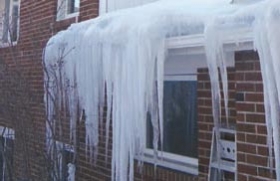We know that ice dams form when there is lots of snow, and winter temperatures are mild; and that heat escaping from the top floor of a house into the attic causes snow to melt, move down the roof, and refreeze at the eave. But walk through neighborhoods in the wintertime and you will notice distinct patterns in the ice dams, depending on when the house was built. There is no doubt that poor construction techniques—a disregard for good air sealing and thorough insulation—are largely responsible for the formation of ice dams. But what about poor design? The fact that many pre-WWI homes have steeply pitched roofs, or that their occupants kept the inside temperature of their homes lower than they do today, may offer a clue as to why these homes seem less prone to severe damage in the living space from ice dams. There is no denying that homes built after WWII—sprawling bungalows with can lights and ductwork in the attic—are much more susceptible to ice damming. What about attic ventilation? Is this another factor in the development of ice dams? Attic ventilation is, in effect, an acknowledgment on the
Read the entire article. Click Here.

